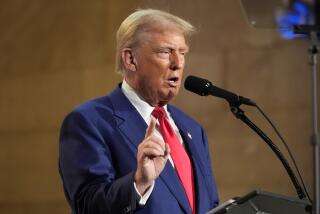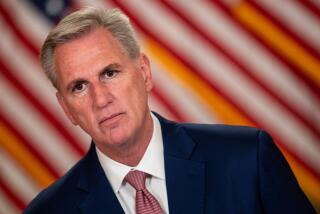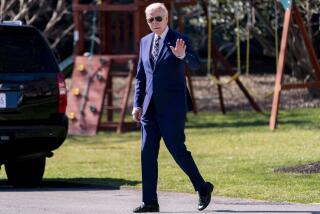Obama pitches jobs plan
WASHINGTON — President Obama rolled out a new jobs plan Thursday designed to quickly provide $447 billion through a mix of tax cuts, construction projects and unemployment relief -- an ambitious move meant to jolt the slumbering economy and answer skeptics who say he’s been too complacent about the hardships borne by millions of unemployed.
Though he spoke to a national television audience, Obama aimed his remarks squarely at Republican lawmakers arrayed before him in the House chamber. Repeatedly during the 32-minute address to the joint session of Congress, Obama characterized his proposal as “the kind that’s been supported by Democrats and Republicans in the past,” implying that but for partisanship, it should be supported again now.
“Every proposal I’ve laid out tonight will be paid for. And every proposal is designed to meet the urgent needs of our people and our communities,” he told lawmakers. “You should pass this jobs plan right away.”
The size of the plan was considerably larger than White House officials had indicated days earlier and reflected a lengthy debate between Obama’s economic and political advisors, according to White House officials who spoke on condition of anonymity to describe internal discussions.
The economic team favored a large-scale plan that would be big enough to noticeably reduce unemployment over the next year, aides said. Obama’s political advisors worried that such a proposal might be blocked in Congress and result in stalemate. In the end, the president seemed to have come down on the side of his economic team.
The resulting proposal cheered many Democrats who have criticized Obama for not doing enough and won support from some outside economists. Mark Zandi, chief economist at Moody’s Analytics, a research and forecasting firm, predicted that Obama’s proposals, if adopted, would add 2 million net jobs in 2012. That would reduce the unemployment rate to about 8% by election time in November.
“It’s a bold effort to provide more support to the economy, certainly bigger than widely anticipated,” Zandi said.
First, of course, Congress would have to pass the plan, and White House officials acknowledged that winning over Republicans who control the House would not be easy.
Part of the strategy for getting the bill through Congress is to insist that it will not increase the federal deficit. Obama said that he would release a plan Sept. 19 to show how that can be done. Though he offered no specifics on that point in the speech, he said he would revive and expand this summer’s plan for a “grand bargain” that would reduce the deficit over the long term by raising some taxes and trimming the cost of Medicare, Medicaid and other programs that traditionally have been supported by Democrats.
Still, the size of the package probably will touch off sticker shock among many GOP lawmakers. At no point in the speech did Obama mention the price tag, perhaps sensing it would be a sore point.
The plan is about half the size of the $787-billion stimulus bill that Congress passed in 2009 -- a measure that Obama and his aides say saved the country from falling into a full-scale depression, but which many Republicans dismiss as an abject failure.
Republican leaders responded tepidly, but seemed to be trying to avoid the “obstructionist” label that Obama has tried to hang around their necks.
House Speaker John A. Boehner of Ohio, who sat solemnly behind the president throughout the address, released a statement later saying that Obama’s ideas “merit consideration.” Majority Leader Eric Cantor of Virginia suggested that Republicans might be willing to adopt at least some of Obama’s ideas, saying, for example, that his proposal for a renewal of this year’s payroll tax cut would be “part of the mix.”
Payroll tax cuts are the largest single element of the plan. Last winter, Congress passed a one-year cut that reduced the payroll tax by 2 percentage points. Obama would expand that cut to 3.1 percentage points and continue it for another year, providing a $1,500 tax cut to the typical American family.
He also would cut by half the employer portion of the payroll tax for businesses with payrolls of less than $5 million -- about half the firms in the nation -- and declare a complete payroll tax “holiday” for newly hired workers or wage increases at firms of any size.
In all, the tax cuts in the package amount to $245 billion.
The other major element is $140 billion that would go directly to providing jobs, largely by updating the nation’s roads, bridges and schools. About $35 billion would go to states to keep teachers, police and firefighters on the job. Government layoffs have been a major drag on employment for much of this year.
The president also called for overhauling the nation’s unemployment insurance program to prevent 5 million Americans who are looking for work from losing their benefits. Officials said his “Bridge to Work” program builds on a controversial Georgia state program that helps pay displaced workers who take temporary or voluntary work. Obama said his plan would ensure the workers earn at least the minimum wage. That plan may also garner GOP support.
Absent from Obama’s proposal were any measures to provide direct relief to distressed homeowners and the housing market, whose condition many experts believe is central to the sluggish recovery.
The speech came at what may be a tipping point in the Obama presidency, with voter frustration over the economy threatening his reelection. Polling in the last week showed a majority of voters unhappy about the nation’s direction and prepared to vote Obama out of office.
The president met the moment with a tactic he has employed at crisis points throughout his tenure: a high-stakes speech.
Now that it is done, the White House will begin a choreographed campaign to pass the plan. On Friday, Obama plans to head to Richmond, Va., Cantor’s home turf, for a speech meant to continue selling the plan to the public.
In the coming weeks, Cabinet members will “fan out” across the country to help spread the message, a White House official said.
--
Don Lee and Lisa Mascaro in the Washington bureau contributed to this report.
--
(BEGIN TEXT OF INFOBOX)
‘WE CAN MAKE A DIFFERENCE’
Presenting a sweeping proposal before a joint session of Congress, President Obama calls for reviving the economy with $447 billion in tax cuts and infrastructure spending. For the complete story, see LATEXTRA, AA1
$250 billion: Tax relief for individuals and businesses.
$140 billion: Spending to upgrade roads, bridges and schools.
$35 billion: Funding for teachers, police and firefighters.
$1,500: Typical family’s savings under expanded payroll tax cut.
More to Read
Get the L.A. Times Politics newsletter
Deeply reported insights into legislation, politics and policy from Sacramento, Washington and beyond. In your inbox three times per week.
You may occasionally receive promotional content from the Los Angeles Times.











